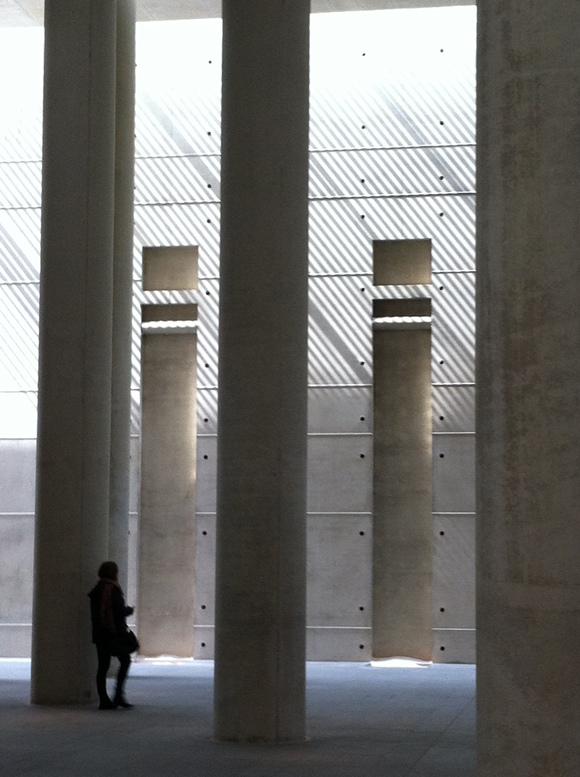 Exkursion
Exkursion
……………………………………………………………………………………………………………………………………………………………………………………………
Crematorium Berlin-Baumschulenweg – A place of countless perceptions
By 1992, the crematorium was in dire need of repair. There was an internationally advertised competition in Berlin, won by the architecture office “Schultes Frank” to repair the damaged building. After the complete tear-down in 1995, the new building was finished in 1999. In the same year, architects Axel Schultes and Charlotte Frank received the architecture prize “Beton”. The goal of the refurbishment was, as the architect (Axel Schultes), wrote, “[to] create a place that balances the temporal and the final, and makes clear the gravity, but also the possibility of relief.”
In 1911 the crematorium Berlin-Baumschulenweg was the first official crematorium in Prussia. Even then, it was an uncommon and long forgotten practice. In the prewar period before WWII, the crematorium was used (until 1939) to cremate captives from the Oranienburg concentration camp Sachsenhausen. It was also an important cemetery during the DDR period. Affluent people, like politicians and public figures, were cremated here in addition to the victims killed at the boundary wall (Berlin Wall).

In the Treptow crematorium, one is introduced to many different elements. The elements have strong symbolic values in history and depending on perspective. The crematorium considers itself to be a neutral place in terms of religion. The ‘chapel’ spaces house transportable/removable crosses, that can be hidden or shown, depending on the type of ceremony a family is seeking. Obviously the extent of this neutrality is arguable, but it does allow for changes. Some elements of the building include fire, water and sand. Fire is a symbol of purification as it releases what it burns as ash. It was the Roman Catholic Church that initiated burial whereas before, it was quite common to be cremated. Water is a symbol of purity, and holds a strong significance in all religions. In Christianity, water is as a symbol of life as well as a means of cleansing or purification. According to the Old Testament, it is introduced when you get baptized. However, baptism is not a ritual in all religions, nor does the significance of water stay the same. The crematorium arguably appeals more strongly to Western religions more so than others.

The new crematorium is a place full of hidden symbols, like niches in the wall alluding to temples in Sakkara that function as closed gateways to the living. Sand, reflecting time and eternity, together with twenty-nine pillars extending from floor to ceiling, create an atmosphere full of both light and shadow. The columns seem almost randomly placed, except that they ripple out from a central pool, where an egg seems to float just above the water’s surface, maybe representational of rebirth. the columns rise to the ceiling, but where they would disappear into the structure of the building, there is an opening to natural light. This symbology is of course an interpretation, as the crematorium considers itself non-denominational.

There are two halls each for fifty persons and one for two-hundred and fifty, where three obsequies, or ceremonies can be held simultaneously. The overall appearance is sobering, seamless, timeless and has a clear design vocabulary made stronger by the uniformity of materials and light control. Of course the openness to all religions is also liberating, making visitors and loved ones of the deceased feel welcomed regardless of background or belief system.
It’s a place which invites the spectator to consider the connection between life and death, grief and confidence. It is spiritual, but not religious. The public space is a crossroad between mortality and the finality, enabling an open space to think, and the possibility of relief.

On the floor below the open lobby part of the crematorium is the technical workings of the institution. Here, the bodies of the deceased are stored, prepared and cremated in a systematized and mechanical process. Although the employees of the crematorium oversee the process, they are able to ‘work from in a distance’ as the machines do most of the moving and transferring of the different steps.
The bereaved family has the possibility to attend the cremation and say a final farewell before the coffin is moved into the oven. From there, the employees and the machines take care of the rest until the remains are delivered back to the family of the deceased. But even downstairs, in the less spiritual part of the building, there is a respectful quietness to the atmosphere. Of course the mechanics of such a place make noise, but there is purpose to that noise. The ground floor of the place is meant for the public, while the downstairs is concealed. The whole process is quite technologic, which provides a fluid procedure-process and ensures some anonymity between employee and the deceased.
Each year there are about ten-thousand cremations completed in three ovens. A cold-store can hold 628 coffins at once with 24 additional spaces for unique cases. The crematorium also functions as a site of architectural appreciation.
Text: Manuel Ahnemüller, Rachel Mendelsohn & Michaela Pihl Olsen
Fotos: Manuel Ahnemüller, Rachel Mendelsohn, Michaela Pihl Olsen & Johanna Ziemann